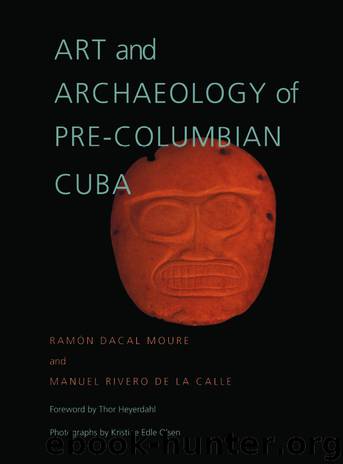Art and Archaeology of Pre-Columbian Cuba by Ramon Dacal Moure

Author:Ramon Dacal Moure
Language: eng
Format: epub
Publisher: University of Pittsburgh Press
* * *
1. Columbus (1989) The “Diario,” p. 192.
2. Las Casas (1951) Historia, vol. 1, p. 246.
3. Fernández de Oviedo (1959) Historia general, vol. 117, p. 149.
4. See Montané (1908) Homme de Sancti Spiritus and (1917) L'Homme fossile cubain.
5. Columbus (1989) The “Diario,” p. 110.
6. Núñez Jimenéz (1985b) El Almirante; Columbus (1989) The “Diario” (1989), p. 122.
THE ART
Ciboney Art and Thought
Two central questions arise concerning the Ciboney: human origins (anthropogenesis) and cultural origins (sociogenesis). The issue of human origins is clear: when the Ciboney reached the Cuban coasts, they were already physically modern humans, so they had the necessary abilities to establish the foundations of human society. But what kind of society was this? Here we are dealing with cultural origins, an extraordinarily complex problem. What was the social state of these groups? We do not know, nor do we understand the cultural evolution of the Ciboney despite having material evidence covering five thousand years and hundreds of sites in distinct locations and environments.
If we take a part of those five thousand years, it is clear that it would be only a single moment within the cultural lifespan of the Ciboney. Therefore, we must deal with the Ciboney period as a whole, although this approach could leave some gaps, either for lack of concrete knowledge or because the topic should be handled in a multidisciplinary fashion.
The Ciboney have left a material culture that allows us to approach their thought, and logic leads us to ask some interesting questions about these first inhabitants of Cuba. We can begin by establishing the known facts. When we analyze the Ciboney settlements that have been excavated, we find the remains of animals acquired by hunting and fishing, traces of hearths, and stone and shell tools. Some sites have wooden tools, ornaments, pigments, bone beads, and enigmatic geometrically shaped objects that show no signs of use as tools. There are many burials with accompanying artifact types, which are repeated in various burial grounds. A set of pictographs is also associated with the Ciboney.
These people knew much of their natural surroundings, information that was indispensable for survival. The different species of the mineral, vegetable, and animal worlds that surrounded them had to be “studied,” given that it was impossible, for instance, to paint their bodies or other objects using minerals to produce colors such as black, red, or yellow without knowing where to find the minerals; or to collect the fruits of different plants without knowing where to locate the plants or when the fruits would be edible. Similarly, in order to fish or to hunt they had to know the habits of the animals to be captured. The concept of time also had to be understood and managed to some degree, because each animal species reproduces and matures in its own fashion. The Ciboney must have measured time, using the sun, the moon, and the stars as a great natural clock.
Excavations have revealed various forms of burial in which objects were deposited together with the corpse.
Download
This site does not store any files on its server. We only index and link to content provided by other sites. Please contact the content providers to delete copyright contents if any and email us, we'll remove relevant links or contents immediately.
The Art of Boudoir Photography: How to Create Stunning Photographs of Women by Christa Meola(18537)
Red Sparrow by Jason Matthews(5390)
Harry Potter 02 & The Chamber Of Secrets (Illustrated) by J.K. Rowling(3620)
In a Sunburned Country by Bill Bryson(3481)
Drawing Cutting Edge Anatomy by Christopher Hart(3454)
Figure Drawing for Artists by Steve Huston(3381)
Harry Potter and the Prisoner of Azkaban (Book 3) by J. K. Rowling(3304)
The Daily Stoic by Holiday Ryan & Hanselman Stephen(3231)
Japanese Design by Patricia J. Graham(3109)
The Roots of Romanticism (Second Edition) by Berlin Isaiah Hardy Henry Gray John(2878)
Make Comics Like the Pros by Greg Pak(2852)
Stacked Decks by The Rotenberg Collection(2811)
Draw-A-Saurus by James Silvani(2655)
Harry Potter and the Deathly Hallows (7) by J.K. Rowling(2641)
Tattoo Art by Doralba Picerno(2600)
On Photography by Susan Sontag(2575)
Churchill by Paul Johnson(2506)
The Daily Stoic by Ryan Holiday & Stephen Hanselman(2459)
Drawing and Painting Birds by Tim Wootton(2438)
